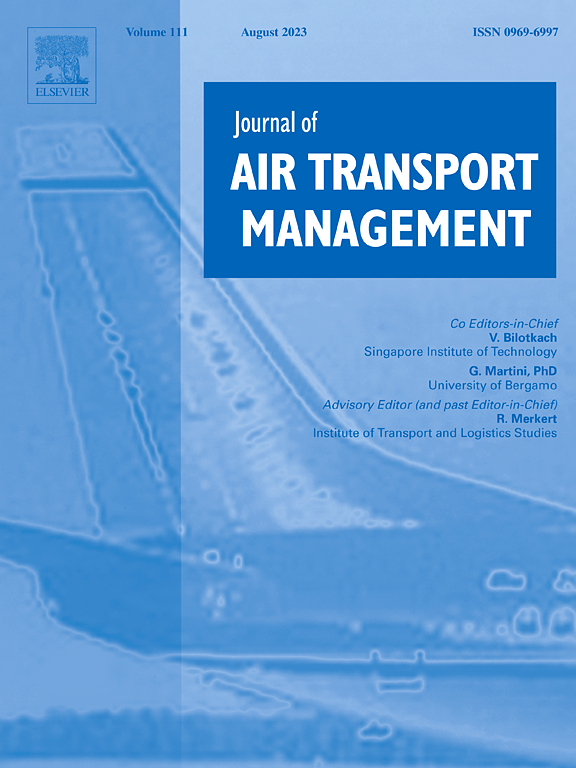调查东盟-欧盟全面航空运输协定对航空公司竞争动态的影响
IF 3.9
2区 工程技术
Q2 TRANSPORTATION
引用次数: 0
摘要
东南亚国家联盟(ASEAN)和欧盟(EU)于2022年10月签署了成员国之间的全面航空运输协定(CATA)。东盟-欧盟航空运输协定是世界上第一个集团对集团的航空运输协定,反映了航空运输监管的最新政策思想。该协议允许两大集团的航空公司通过行使“第五自由”(Fifth Freedom)交通权和放开代码共享限制,在这两个地区之间和以外运营客运和货运服务。自2014年以来,尽管双方都承诺将其航空关系提升到一个新的水平,但两个地区在国内航空旅行市场一体化和自由化水平方面仍然存在差异。这些内在的变化导致了东盟航空公司与欧盟航空公司相比在竞争地位上处于劣势。本研究旨在通过运用竞争动力学模型来分析战略和应对中的相互作用,以及其对相关航空公司绩效的影响,调查CATA对两个市场中航空公司竞争动态的可能影响。利用二手数据,采用一系列定量指标来检查选定的东盟和欧盟承运人的意识、动机和能力,以应对行业监管和竞争环境的新变化。尽管调查结果表明,东盟和欧盟航空公司的战略反应更侧重于航线间协议和合资企业,但在泰国和新加坡等热门目的地,竞争依然激烈。该研究分析了中东三大航空公司和土耳其航空公司在定期航班频率和票价方面的优势,相对于东盟和欧盟主要枢纽的本土航空公司。由cata促成的部分自由化市场将推动东盟和欧盟航空公司之间建立更多合作伙伴关系,以调整各自枢纽的时间表,以应对中东航空公司带来的竞争。研究结果表明,在新的东盟-欧盟航空运输联盟框架内,航空公司之间可能采取的行动和反应是推动市场结构随时间变化的前兆。本文章由计算机程序翻译,如有差异,请以英文原文为准。
Investigating the impacts of ASEAN-EU comprehensive air transport agreement on the carriers’ competitive dynamics
The Association of Southeast Asian Nations (ASEAN) and the European Union (EU) signed the Comprehensive Air Transport Agreement (CATA) between their member states in October 2022.
The ASEAN-EU CATA is the world's first bloc-to-bloc air transport agreement and reflects the latest policy thinking in air transport regulation. The agreement allows the carriers of the two blocs to operate passenger and cargo services between and beyond both regions, by exercising Fifth Freedom traffic rights and liberalising codeshare restrictions.
Since 2014 and despite both sides showing a commitment to elevating their aviation relations to a new level, the two regions remain different regarding the level of domestic air travel market integration and liberalisation. These intrinsic variations contribute to creating disadvantages in the competitive position of ASEAN-based carriers when compared to their EU counterparts.
This study aims to investigate the possible implications of the CATA on the competitive dynamics of airlines in both markets, by applying the Competitive Dynamics Model to analyse the interactions in the strategies and responses, and its implications on the performance of the relevant air carriers. Using secondary data, a series of quantitative indicators are utilised to examine selected ASEAN and EU carriers' awareness, motivation, and ability to respond to the novel changes in the industry's regulatory and competitive environment.
While the findings indicate the strategic responses of both ASEAN and EU carriers is more focussed on interline agreements and joint ventures, competitive rivalry is to remain intense for popular destinations such as those to and from Thailand and Singapore.
The study analyses the advantages in the scheduled frequencies and fares of the big three Middle Eastern carriers and Turkish Airlines, over home airlines in major ASEAN and EU hubs. The CATA-induced partially liberalised market will drive more partnerships among ASEAN and EU carriers to align schedules in their respective hubs as a response to competition posed by Middle Eastern carriers. The findings suggest that the possible actions and reactions of airlines to one another are precursors to driving changes in market structure over time within the new ASEAN-EU CATA framework.
求助全文
通过发布文献求助,成功后即可免费获取论文全文。
去求助
来源期刊

Journal of Air Transport Management
TRANSPORTATION-
CiteScore
12.40
自引率
11.70%
发文量
97
期刊介绍:
The Journal of Air Transport Management (JATM) sets out to address, through high quality research articles and authoritative commentary, the major economic, management and policy issues facing the air transport industry today. It offers practitioners and academics an international and dynamic forum for analysis and discussion of these issues, linking research and practice and stimulating interaction between the two. The refereed papers in the journal cover all the major sectors of the industry (airlines, airports, air traffic management) as well as related areas such as tourism management and logistics. Papers are blind reviewed, normally by two referees, chosen for their specialist knowledge. The journal provides independent, original and rigorous analysis in the areas of: • Policy, regulation and law • Strategy • Operations • Marketing • Economics and finance • Sustainability
 求助内容:
求助内容: 应助结果提醒方式:
应助结果提醒方式:


